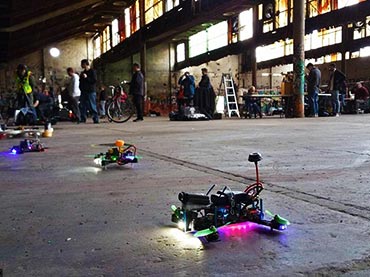“It just blew me away,” says Nowak, recalling the first time he discovered First Person View (FPV) drone racing. Chad Nowak has always been fascinated by anything that glides through the air. He’s been flying remote controlled aircraft for 25 years. When he came across a video on Youtube that featured the underground sport of FPV drone racing.
Two weeks after watching the video, Nowak bought himself his first FPV drone kit. He built his own quad and met with other guys who were into the emerging sport. Today his home in Queensland, Australia is full of half-built quadcopters and other loose parts.
According to the “flyers,” the big part why the sport is addictive is the FPV goggles worn by the competitors. The FPV stream video from the drones’ front-facing camera as they fly through the air at the speed of 100 mph or more. The experience is a unique mix of virtual reality and video gaming, an out-of-body-like experience.
Nowak states it perfectly when he said “When I fly full-sized aircraft I see things and think, ‘oh it would be so fun to dive in between that,’ but I can’t because it’s my life at stake and you’ve got to take it a bit more seriously. With these thing I can now do that. And if I get it wrong, worst case, I break a frame and I have to build a new one.”



The race was held in a dilapidated building. The racers were a sight to behold. In a few minutes, these flyers will be racing their quads against each other. The racecourse snakes its way up and down a huge open room. A low hanging ceiling presents as a threat to flyers flying too high while rows of red pylons with red tape serve as the race barriers.
An area is sectioned off for the pilots and for those who came to watch the race. People gather around a large monitor that broadcasts vision from a drone’s camera as it zips through the track. Some spectators brought along their own FPV goggles so they can tune into one of channels of their favorite racers. Pilots who aren’t racing are busy tinkering their machines in the background.


[dfp1]


FPV drone racing isn’t as expensive as you might think. Popular camera drones like DJI’s Phantoms and Parrot’s Bepop might cost you US$1,000 but the DIY quadcopters that are designed to go fast as possible comes at a cheaper price. According to Covert, flying parts costs around $200, goggles for US$20, a receiver for US$30, and a transmitter for $40. You can start flying for US$230 to US$310.
With relatively cheap machines that will only get better as technology advances, it is easy to see why the FPV racing community is very excited about the direction of their sport.
Nowak is known as one of the fastest pilots in Australia’s drone racing collective. He was able to land a sponsor that will finance his trip to the US. Nowak will compete there among a field of 200 pilots from around the world for the first national Drone Racing Championships. The Champions has a US$25,000 cash prize for the winner. Something that Nowak and his comrades didn’t expect.
FPV racing leagues are starting to pop up around the world, some offer cash prizes others are like the one in Australia. The French Alps’ forest has already hosted a race. With drone racing becoming more popular in the US and England, pilots are hoping to see their sport held in a professional arena in the future.



[dfp2]



Check out the video below to see the drones in action.


